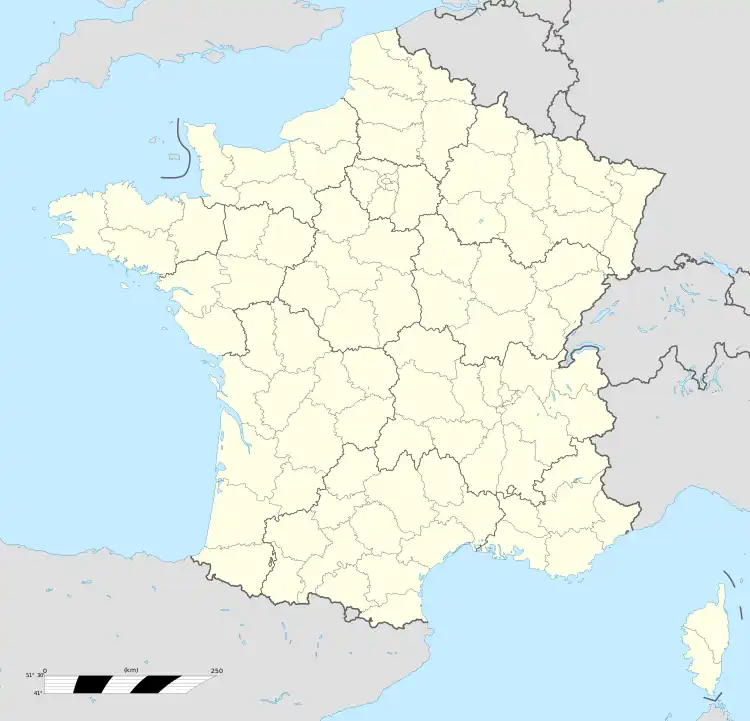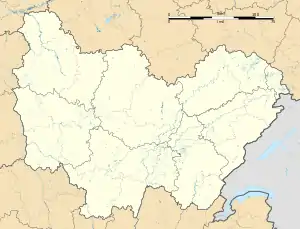Toury-Lurcy | |
|---|---|
 The church in Toury-Lurcy | |
Location of Toury-Lurcy | |
 Toury-Lurcy  Toury-Lurcy | |
| Coordinates: 46°44′22″N 3°25′33″E / 46.7394°N 3.4258°E | |
| Country | France |
| Region | Bourgogne-Franche-Comté |
| Department | Nièvre |
| Arrondissement | Nevers |
| Canton | Saint-Pierre-le-Moûtier |
| Government | |
| • Mayor (2020–2026) | Guy Hourcabie[1] |
| Area 1 | 25.54 km2 (9.86 sq mi) |
| Population | 407 |
| • Density | 16/km2 (41/sq mi) |
| Time zone | UTC+01:00 (CET) |
| • Summer (DST) | UTC+02:00 (CEST) |
| INSEE/Postal code | 58293 /58300 |
| Elevation | 197–252 m (646–827 ft) |
| 1 French Land Register data, which excludes lakes, ponds, glaciers > 1 km2 (0.386 sq mi or 247 acres) and river estuaries. | |
Toury-Lurcy (French pronunciation: [tuʁi lyʁsi]) is a commune in the Nièvre department in central France.[3]
History
From the 12th century, the village of Toury-Lurcy (formerly Thoriacum or Toriaco) was one of the fiefdoms of the Counts of Thoury (hence its name).
In 1161, the bishop of Nevers, Bernard of Saint-Saulge, recognized by letters sent to the abbot of St. Martin, Autun, that this church in his diocese was the property of the abbey, which was confirmed in 1164 by a bull of Pope Alexander III, then a refugee in France.[4] The family of Richard de Soultrait were the local lords.
The town was created in 1823 from the merger of Toury and Lurcy-sur-Abron.
The Château de Toury-Lurcy, rebuilt in 1776 on a medieval site, is classified and registered as a historical monument.[5]
Notable people
- Georges de Soultrait, count, regional historian, born and died at Toury (1822-1888).[6]
- Jean Saulnier, knight, lord of Thoury-sur-Abron, councilor and chamberlain of the king, steward of Isabeau, duchess of Bourbonnais, and bailiff of Saint-Pierre-le-Moûtier, died in 1389.[7]
- Agnes de Tressolles, wife of Jean Saulnier.
- Florimond-Augustin Daubois, parish priest of Toury from 1710 to 1742, left many precious annotations on the margins of his actions in the parish registers.[8]
Population
| Year | Pop. | ±% p.a. |
|---|---|---|
| 1968 | 451 | — |
| 1975 | 406 | −1.49% |
| 1982 | 389 | −0.61% |
| 1990 | 442 | +1.61% |
| 1999 | 427 | −0.38% |
| 2009 | 424 | −0.07% |
| 2014 | 420 | −0.19% |
| 2020 | 409 | −0.44% |
| Source: INSEE[9] | ||
See also
References
- ↑ "Répertoire national des élus: les maires" (in French). data.gouv.fr, Plateforme ouverte des données publiques françaises. 13 September 2022.
- ↑ "Populations légales 2021". The National Institute of Statistics and Economic Studies. 28 December 2023.
- ↑ INSEE commune file
- ↑ Cartulaire de l'abbaye de Saint-Martin d'Autun: Charte N° XVIII
- ↑ Base Mérimée: Château, Ministère français de la Culture. (in French)
- ↑ Bulletin de la Société nivernaise des lettres, sciences et arts, volume 50, pages 12-13, 2001.
- ↑ Abbé Jacques-François Baudiau, Le Morvand, Nevers, 1865; 3e éd. Guénégaud, Paris, 1965, 3vol., tII, p. 152.
- ↑ Abbé Jacques-François Baudiau, Le Morvand, Nevers, 1865; 3e éd. Guénégaud, Paris, 1965, 3vol., tII, p. 152.
- ↑ Population en historique depuis 1968, INSEE